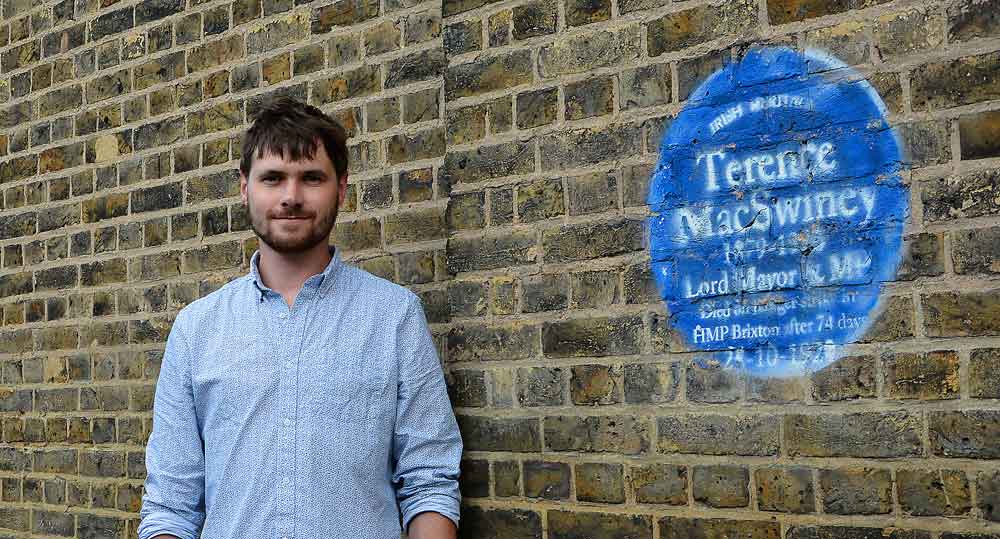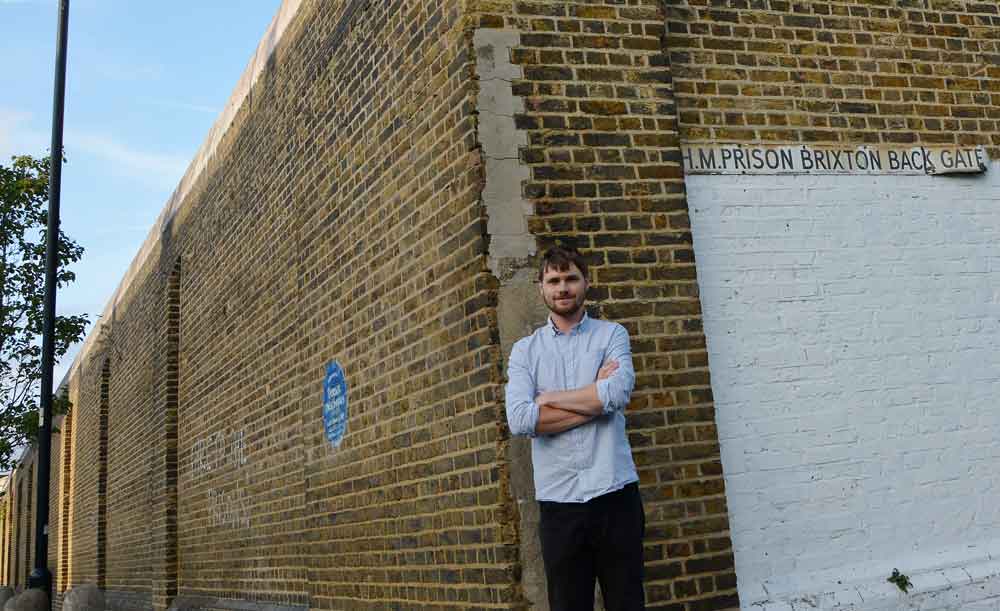Nearly 100 years ago events in Brixton drew the attention of people ranging from Clement Attlee to Marcus Garvey. Local resident Fergus O’Farrell recalls the death of Terence MacSwiney

On the boundary wall of Brixton Prison, adjacent to Lyham Road, there is a blue plaque commemorating a former prisoner.
It has not been put there by English Heritage, the group which erects blue plaques to remember famous people around London. This one is spray-painted on the wall, and it commemorates an unlikely figure – Terence MacSwiney, an Irish Republican, who died in the prison in 1920.
MacSwiney came of age at a time of tension in Ireland when separatists were looking for independence from Britain. Having been denied the freedom which they had voted for in successive elections from the 1870s until the 1910s, extremists took matters into their own hands and staged an armed rebellion against British rule in Dublin in 1916.
While MacSwiney did not take an active role in the uprising, he was, nonetheless, closely aligned with the rebels. He was a devout – even puritanical – Catholic, a published playwright, an Irish language scholar and a teacher.
He was elected Sinn Féin MP for Mid Cork in the General Election of December 1918, but refused to take his seat in Westminster, as he did not recognise Britain’s territorial claim over Ireland.
The Irish War of Independence broke out the following month, and MacSwiney’s home city of Cork was a particularly active and bloody area for its duration. In March 1920, the Lord Mayor of Cork, Tomás Mac Curtain, was shot dead by police as he slept in his bed. In a city so riled by warfare, a man of MacSwiney’s standing and character was a natural replacement.
However, he did not remain in office very long. In August he was arrested and tried by a military tribunal under the Defence of the Realm Act, where he was sentenced to two years imprisonment to be served in Brixton.
MacSwiney immediately began a hunger strike. His case attracted worldwide media attention. Within days, thousands of his supporters flocked to Brixton and rallied outside the prison on Brixton Hill.
On 25 August, a riot broke out between the crowd and the police. The case divided British politics, with some MPs urging that MacSwiney be released. Even the King favoured clemency, though he decided not to interfere publicly.

According to The Observer: ‘The majority of public opinion and of the press in Great Britain is unquestionably for the Lord Mayor’s release. The instinct of this public opinion is unquestionably sound. A government not guided by it in such a matter must be dangerously out of touch with it. What moves the country is the doubt hanging over the case – just the fear of cruel disproportion between death and the offence.”
The government held out, and so did MacSwiney. Messages of support poured in from all over the world. Another radical who would later become associated with Brixton, Marcus Garvey, sent a message of solidarity and conveyed “the sympathy of 400,000,000 negroes”. Some 10,000 people demonstrated in Glasgow. The Mayor of New York telegrammed the Prime Minister, Lloyd George, to urge him to end “the imprisonment of Lord Mayor MacSwiney whose heroic fortitude in representing even unto death the opinions of the citizens who elected him has won the admiration of all the peoples who believe in rule of the people by the people”.
After 74 days without food, MacSwiney died on 25 October. His martyrdom inspired many future revolutionaries. A young Vietnamese man named Nguyen Tat Thanhn was working in the kitchen of a central London hotel. Upon hearing the news of MacSwiney’s death, he burst into tears saying “a country with a citizen like this will never surrender”. He returned to Vietnam, changed his name to Ho Chi Minh, and led the Vietnamese resistance movement for three decades fighting Japanese and French imperialists and later the United States.
MacSwiney’s body was taken to Southwark Cathedral. Thousands came to pay their respects, including the Mayor of Stepney, Clement Attlee, who would later become the Prime Minister.
After the funeral mass, the body was carried to Euston Station in a procession that stretched more than a mile. It was led by mounted police, followed by members of the Irish Volunteer movement and hundreds of priests.
Many police officers wore black gloves as a sign of respect and they saluted the coffin as it passed. The body was put on a train bound for Holyhead, where it was transported by boat to Ireland.
Messages of support poured in from all over the world. Marcus Garvey wrote: “Hundreds and thousands of Irishmen have died as martyrs to the cause of Irish freedom … They compelled the attention of the world and I believe the death of McSweeney (sic) did more for the freedom of Ireland today than probably anything they did for 500 years prior to his death.” Gandhi and Nehru later cited MacSwiney’s protest as an inspiration, as did Nelson Mandela.
Is it time for English Heritage to honour the memory of MacSwiney with a permanent blue plaque?
Fergus O’Farrell’s first book, a biography of the Irish revolutionary Cathal Brugha, has just been published: Cathal Brugha; University College Dublin Press; ISBN-13: 9781910820278.






